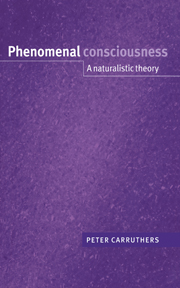Book contents
- Frontmatter
- Contents
- List of figures
- Preface
- 1 Assumptions, distinctions, and a map
- 2 Perspectival, subjective, and worldly facts
- 3 Explanatory gaps and qualia
- 4 Naturalisation and narrow content
- 5 First-order representationalism
- 6 Against first-order representationalism
- 7 Higher-order representationalism: a first defence
- 8 Dispositionalist higher-order thought theory (1): function
- 9 Dispositionalist higher-order thought theory (2): feel
- 10 Phenomenal consciousness and language
- 11 Fragmentary consciousness and the Cartesian theatre
- Conclusion
- References
- Author index
- Subject index
4 - Naturalisation and narrow content
Published online by Cambridge University Press: 30 September 2009
- Frontmatter
- Contents
- List of figures
- Preface
- 1 Assumptions, distinctions, and a map
- 2 Perspectival, subjective, and worldly facts
- 3 Explanatory gaps and qualia
- 4 Naturalisation and narrow content
- 5 First-order representationalism
- 6 Against first-order representationalism
- 7 Higher-order representationalism: a first defence
- 8 Dispositionalist higher-order thought theory (1): function
- 9 Dispositionalist higher-order thought theory (2): feel
- 10 Phenomenal consciousness and language
- 11 Fragmentary consciousness and the Cartesian theatre
- Conclusion
- References
- Author index
- Subject index
Summary
In the present chapter I shall begin surveying the prospects for a naturalistic account of phenomenal consciousness, taking us through some of the initial options. Our attention will quite soon come to focus on theories which employ some combination of causal role and intentional content – that is, theories which are both functional–boxological and representational in character. I shall then suggest that intentional content should be characterised narrowly for purposes of psychological explanation in general, and for deployment in proposed reductive explanations of phenomenal consciousness in particular.
Neural identities and consciousness boxes
This section will take us briskly through the second two (post-mysterian) choice-points in the tree of consciousness depicted in figure 1.1.
Neural correlates versus neural identities
In looking for an explanation of phenomenal consciousness, some have sought to identify it with certain kinds of neural activity in the brain. For example, Baars (1997) identifies phenomenal consciousness with activity in the primary sensory areas of the cortex (in the case of visual experience, within area V1 of the visual cortex – see figure 6.2). This is largely on the grounds of brain-scanning data – people report phenomenally conscious experiences when and only when those regions of the brain are differentially active. Of course such data cannot, by themselves, do more than establish a neural correlate of phenomenal consciousness; they do not show that the phenomenal consciousness is the brain activity. But it might be thought that we can then argue for an identity, by means of an inference to the best explanation.
- Type
- Chapter
- Information
- Phenomenal ConsciousnessA Naturalistic Theory, pp. 88 - 113Publisher: Cambridge University PressPrint publication year: 2000



